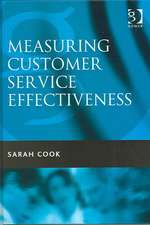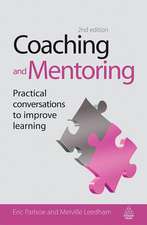The Essential Guide to Employee Engagement – Better Business Performance through Staff Satisfaction
Autor Sarah Cooken Limba Engleză Paperback – 2 iul 2008
Engaged employees are more productive, engender greater customer satisfaction and loyalty, and help promote a company's brand. The Essential Guide to Employee Engagement provides the tools necessary to make this happen.
This book explores the concept and practice behind creating an engaged workforce and how this can contribute to organizational success. Cook draws on case studies and examples from globally recognized companies to demonstrate how actively engaged employees assist the progress of their organization. She shows managers how to measure the level of their employees' engagement and provides them with strategies to help increase staff participation.
This book explores the concept and practice behind creating an engaged workforce and how this can contribute to organizational success. Cook draws on case studies and examples from globally recognized companies to demonstrate how actively engaged employees assist the progress of their organization. She shows managers how to measure the level of their employees' engagement and provides them with strategies to help increase staff participation.
Preț: 301.84 lei
Nou
Puncte Express: 453
Preț estimativ în valută:
57.76€ • 62.72$ • 48.52£
57.76€ • 62.72$ • 48.52£
Carte tipărită la comandă
Livrare economică 23 aprilie-07 mai
Preluare comenzi: 021 569.72.76
Specificații
ISBN-13: 9780749449445
ISBN-10: 0749449446
Pagini: 240
Ilustrații: 1
Dimensiuni: 156 x 234 x 13 mm
Greutate: 0.34 kg
Editura: Kogan Page
ISBN-10: 0749449446
Pagini: 240
Ilustrații: 1
Dimensiuni: 156 x 234 x 13 mm
Greutate: 0.34 kg
Editura: Kogan Page
Cuprins
Preface
1. What is employee engagement?
What is employee engagement?
A definition of employee engagement
The power of the customer
Customer experience
The power of the employee
Is employee engagement a Western phenomenon?
Customer engagement
So how can you identify an actively engaged employee?
Employee commitment and satisfaction does not equate to engagement
Engagement versus satisfaction and loyalty
The benefits of employee engagement
Employee engagement and human capital management
How focusing on employee engagement will help change the perception of the HR function
Is employee engagement worth the investment, will it be a trend to last?
Checklist: What are the benefits of employee engagement for your business?
2 Beginning an employee engagement programme
Gaining buy-in
The starting point for developing an employee engagement strategy
Measuring employee engagement
Employee engagement surveys
Proprietary surveys
Be prepared to expect differing levels of engagement across your organization
Assess your current levels of employee engagement
Example engagement survey questions
Positioning the survey
Checklist: What measurements of engagement are right for your business?
3 Identifying the key drivers of engagement in your business
Using the results of employee engagement surveys
Facilitating a focus group discussion about the key drivers of engagement
Feeding back the results
Summarising the findings of a survey in order to help develop a strategy
Importance and impact
What are the key drivers of employee engagement in your business?
4. Developing an employee engagement strategy
The process of developing a strategy
The WIFI model
Assess your organization’s greatest areas of development using WIFI
How to interpret your score
Transformational change
Creating an employee engagement programme
Work breakdown structure
Four stages of an employee engagement programme
Defining roles and responsibilities
The project scoping process
Planning resources
Working well as a project team
Checklist: Which of the four elements of WIFI need to be improved in your organization?
5. Well-being
What is well-being?
Motivation
Affiliation and meaning
Corporate social responsibility (CSR)
The employer brand
Brand and organizational values
A process for defining organizational values
Translating values into behaviours
A reminder
Increased workload and stress levels
Work--life balance
The long-hours culture
Different types of flexible working
Employee welfare
Job design and resources
Feeling valued
Checklist: What is your organization doing in terms of CSR, employer brand, organizational values, the welfare of staff?
6. Information
Where are we going?
Communicating a clear sense of direction
Being clear on terminology
Developing a vision of the future
Creating a compelling organizational vision
Communicating the vision in an engaging manner
Strategic goals
Keeping people informed
Using different media
Internal communications department
Making information interactive and continuous
Best practice in internal communications
Personal presence and impact
Helping senior leaders to improve their communication style
Checklist: How does your organization inform employees in a motivating way about the business’s vision and strategic objectives?
7. Fairness
Respecting the individual
Recruitment and selection
Induction
Performance management
Reviewing the ‘what’ and the ‘how’
Learning and development
Career development and succession planning
Talent management
Reward and recognition
Checklist: Are the stages in your employees’ journey fair?
8. Involvement
Three levels of involvement
The role of direct line managers in involving their team
Coaching and facilitation skills
Involvement with other teams
Involvement with senior managers
Senior managers as role models
Internal communications departments
Checklist: What does your organization do in terms of involvement?
9. Agents for change
Employee champions
Ability to read the political landscape
Influencing skills
Coaching skills
Marketing skills
The key role of leaders
Leadership practices
Critical actions senior leaders can take to build employee engagement
Providing ongoing development for leaders
Helping leaders identify their development needs
Engendering trust
Communicate, communicate, communicate
Developing listening skills
Personal reflection
Use 18- or 36-degree feedback to identify strengths and development needs
People join organizations and leave bosses
The influence of line managers
Support and challenge
The link to feedback
Beliefs about feedback
Effective management development
What type of environment do you create?
Checklist: What specific skills and abilities will you need to help you encourage employee engagement?
10. Sustaining a focus on employee engagement
Engagement scores beginning to rise
Continue measuring and benchmarking
Do the organization’s strategic goals encompass employee engagement?
Embedding engagement as a key strategic objective and performance indicator
Integrate engagement into the balanced scorecard
Conclusion
References
Further reading
Index
1. What is employee engagement?
What is employee engagement?
A definition of employee engagement
The power of the customer
Customer experience
The power of the employee
Is employee engagement a Western phenomenon?
Customer engagement
So how can you identify an actively engaged employee?
Employee commitment and satisfaction does not equate to engagement
Engagement versus satisfaction and loyalty
The benefits of employee engagement
Employee engagement and human capital management
How focusing on employee engagement will help change the perception of the HR function
Is employee engagement worth the investment, will it be a trend to last?
Checklist: What are the benefits of employee engagement for your business?
2 Beginning an employee engagement programme
Gaining buy-in
The starting point for developing an employee engagement strategy
Measuring employee engagement
Employee engagement surveys
Proprietary surveys
Be prepared to expect differing levels of engagement across your organization
Assess your current levels of employee engagement
Example engagement survey questions
Positioning the survey
Checklist: What measurements of engagement are right for your business?
3 Identifying the key drivers of engagement in your business
Using the results of employee engagement surveys
Facilitating a focus group discussion about the key drivers of engagement
Feeding back the results
Summarising the findings of a survey in order to help develop a strategy
Importance and impact
What are the key drivers of employee engagement in your business?
4. Developing an employee engagement strategy
The process of developing a strategy
The WIFI model
Assess your organization’s greatest areas of development using WIFI
How to interpret your score
Transformational change
Creating an employee engagement programme
Work breakdown structure
Four stages of an employee engagement programme
Defining roles and responsibilities
The project scoping process
Planning resources
Working well as a project team
Checklist: Which of the four elements of WIFI need to be improved in your organization?
5. Well-being
What is well-being?
Motivation
Affiliation and meaning
Corporate social responsibility (CSR)
The employer brand
Brand and organizational values
A process for defining organizational values
Translating values into behaviours
A reminder
Increased workload and stress levels
Work--life balance
The long-hours culture
Different types of flexible working
Employee welfare
Job design and resources
Feeling valued
Checklist: What is your organization doing in terms of CSR, employer brand, organizational values, the welfare of staff?
6. Information
Where are we going?
Communicating a clear sense of direction
Being clear on terminology
Developing a vision of the future
Creating a compelling organizational vision
Communicating the vision in an engaging manner
Strategic goals
Keeping people informed
Using different media
Internal communications department
Making information interactive and continuous
Best practice in internal communications
Personal presence and impact
Helping senior leaders to improve their communication style
Checklist: How does your organization inform employees in a motivating way about the business’s vision and strategic objectives?
7. Fairness
Respecting the individual
Recruitment and selection
Induction
Performance management
Reviewing the ‘what’ and the ‘how’
Learning and development
Career development and succession planning
Talent management
Reward and recognition
Checklist: Are the stages in your employees’ journey fair?
8. Involvement
Three levels of involvement
The role of direct line managers in involving their team
Coaching and facilitation skills
Involvement with other teams
Involvement with senior managers
Senior managers as role models
Internal communications departments
Checklist: What does your organization do in terms of involvement?
9. Agents for change
Employee champions
Ability to read the political landscape
Influencing skills
Coaching skills
Marketing skills
The key role of leaders
Leadership practices
Critical actions senior leaders can take to build employee engagement
Providing ongoing development for leaders
Helping leaders identify their development needs
Engendering trust
Communicate, communicate, communicate
Developing listening skills
Personal reflection
Use 18- or 36-degree feedback to identify strengths and development needs
People join organizations and leave bosses
The influence of line managers
Support and challenge
The link to feedback
Beliefs about feedback
Effective management development
What type of environment do you create?
Checklist: What specific skills and abilities will you need to help you encourage employee engagement?
10. Sustaining a focus on employee engagement
Engagement scores beginning to rise
Continue measuring and benchmarking
Do the organization’s strategic goals encompass employee engagement?
Embedding engagement as a key strategic objective and performance indicator
Integrate engagement into the balanced scorecard
Conclusion
References
Further reading
Index
Recenzii
"An outstanding, practical guide based on real-world experience." -- The Midwest Book Review
Notă biografică
Sarah Cook is the Managing Director of The Stairway Consultancy Ltd. She has more than 20 years' consulting experience specialising in leadership and management development. Before this, Sarah worked for Unilever and as head of customer care for a retail marketing consultancy.Sarah has practical experience helping managers to manage remotely and create high-performing teams. She has also worked extensively with team members to help them effectively transition to new ways of working. Sarah is a business author and has written widely on leadership, management development, team building and coaching. She also speaks regularly at conferences and seminars on these topics.Sarah is a Fellow of the Chartered Institute of Personnel Development and is a Chartered Marketer. She has an MA from the University of Cambridge and an MBA from The Open University. She is also an accredited user of a wide range of psychometric and team diagnostic tools.
Descriere
Cook uses case studies to demonstrate how engaged employees assist the progress of their organization. She shows managers how to measure the level of their employees' engagement and increase staff participation.




















